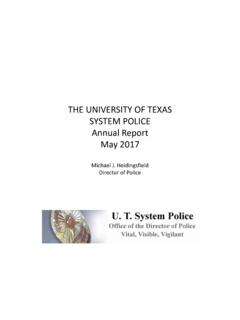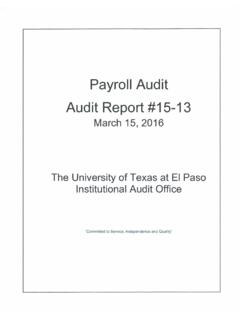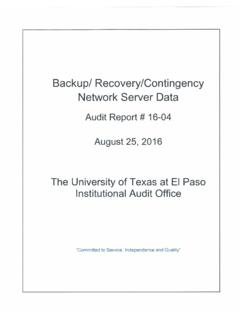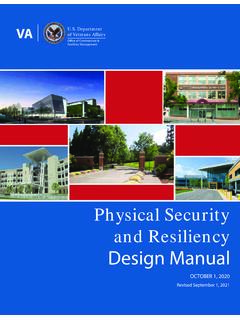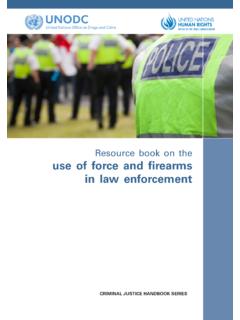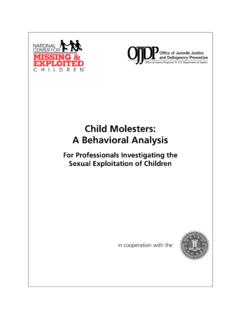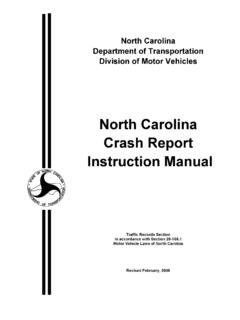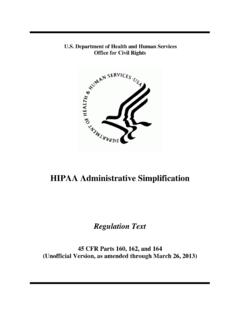Transcription of A Guide For Law Enforcement
1 Crime Scene Investigation 2013A Guide For Law EnforcementBureau of Justice Department of JusticeCRIME SCENE INVESTIGATION A Guide for Law Enforcement i Crime Scene Investigation A Guide for Law Enforcement September 2013 Original Guide developed and approved by the Technical Working Group on Crime Scene Investigation, January 2000. Updated Guide developed and approved by the Review Committee, September 2012. Project Director: Kevin Lothridge Project Manager: Frank Fitzpatrick National Forensic Science Technology Center 7881 114th Avenue North Largo, FL 33773 CRIME SCENE INVESTIGATION A Guide for Law Enforcement ii Revision of this Guide was conducted by the National Forensic Science Technology Center (NFSTC), supported under cooperative agreements 2009-D1-BX-K028 and 2010-DD-BX-K009 by the Bureau of Justice Assistance, and 2007-MU-BX-K008 by the National Institute of Justice, Office of Justice Programs, Department of Justice.
2 This document is not intended to create, does not create, and may not be relied upon to create any rights, substantive or procedural, enforceable at law by any party in any matter, civil or criminal. Opinions or points of view expressed in this document represent a consensus of the authors and do not necessarily reflect the official position of the Department of Justice. CRIME SCENE INVESTIGATION A Guide for Law Enforcement Contents A. Arriving at the Scene: Initial Response/ Prioritization of Efforts .. 1 1. Initial Response/ Receipt of Information .. 1 2. Safety Procedures .. 2 3. Emergency Care .. 2 4. Secure and Control Persons at the Scene .. 3 5. Boundaries: Identify, Establish, Protect and Secure .. 4 6. Turn Over Control of the Scene and Brief Investigator(s) in Charge .. 6 7. Document Actions and Observations .. 6 8. Establish a Command Post (Incident Command System) and Make 7 9. Manage Witnesses .. 8 B. Preliminary Documentation and Evaluation of the Scene.
3 10 1. Conduct Scene Assessment .. 10 2. Conduct Scene Walk-Through and Initial Documentation .. 11 3. Note-Taking and Logs .. 13 C. Processing the Scene .. 15 1. Determine Team Composition .. 15 2. Ensure Contamination Control .. 15 3. Documentation .. 16 Sketching .. 17 27 Videography .. 35 4. Prioritize Collection of Evidence .. 38 5. Crime Scene Search Methods .. 39 6. Collect, Preserve, Inventory, Package, Transport, and Submit Evidence .. 42 7. Detailed Crime Scene Evidence Collection .. 42 Ignitable Liquids .. 43 Bodily Fluids .. 43 Male Suspect Evidence Collection, Including Sexual Assault .. 54 Bombs and Explosives .. 56 CRIME SCENE INVESTIGATION A Guide for Law Enforcement Documents .. 57 61 Ammunition .. 67 Tool Mark Evidence .. 71 Trace Evidence .. 73 Footwear and Tire Impressions .. 98 Footwear Impression Evidence .. 101 Motor Vehicles .. 111 Electronic and Digital Evidence .. 113 Fingerprints .. 134 Comparison/Elimination Prints.
4 139 Tool Mark Evidence .. 142 D. Completing and Recording the Crime Scene Investigation .. 145 1. Establish Crime Scene Debriefing Team .. 145 2. Perform Final Survey of the Crime Scene .. 146 3. Documentation of the Crime Scene .. 146 4. Acknowledge Specialized Crime Scene Circumstances .. 147 Crime Scene Investigation in Correctional and Custodial Facilities .. 148 Time-Limited Crime Scene Investigation .. 149 E. Crime Scene Equipment .. 150 1. Initial Responding Officer(s) .. 150 2. Crime Scene Investigator/Evidence Technician .. 151 3. Evidence Collection Kits (Examples) .. 153 F. Appendices .. i Appendix A. ii Appendix B. Reference List .. viii Appendix C. Diagrams .. x CRIME SCENE INVESTIGATION A Guide for Law Enforcement v Acknowledgements This updated Crime Scene Investigation: A Guide to Law Enforcement is a revision of the original publication published in January 2000, and borrows heavily from that work. The original publication was based upon the work of the National Crime Scene Planning Panel and additional Technical Working Group Members.
5 Their contributions remain as vital today as when the original Guide was published. To develop this expanded edition, a Review Committee of recognized experts was assembled. This committee selected additional material from content developed for Department of Justice funded crime scene projects, Scientific Working Groups and other open-source documents, which are reflected in the Reference section. Additional vetting of the material was accomplished through recognized subject matter experts. NFSTC wishes to thank the Bureau of Justice Assistance (BJA), the National Institute of Standards and Technology (NIST) and the National Institute of Justice (NIJ) for providing input to this project. The resulting document includes detailed procedural guides for the complete range of crime scene investigation tasks from securing the scene to submitting the evidence. This publication provides law Enforcement professionals and first responders step-by-step guidance in this crucial first phase of the justice process.
6 Agencies are encouraged to use this reference to enhance existing training and promote quality. While these methods can be implemented at any agency, jurisdictions will want to carefully consider the procedures and their applicability to local agencies and circumstances. CRIME SCENE INVESTIGATION A Guide for Law Enforcement National Crime Scene Planning Panel (NCSPP) January 2000 Dr. Jos R. Almirall, Associate Director/ Assistant Professor International Forensic Research Institute Department of Chemistry Florida International University Miami, Florida Susan Ballou, Forensic Scientist Montgomery County Police Department Crime Laboratory Rockville, Maryland Paul Carroll, Sergeant (Ret.) Chicago Police Department Big Pine Key, Florida Elizabeth Farris, Chief Trial Counsel Hampden County District Attorney s Office Springfield, Massachusetts Jo Ann Given, ASCLD/LAB Naval Criminal Investigative Service Norfolk, Virginia Marjorie Harris, Senior Forensic Scientist Department of Criminal Justice Division of Forensic Science Richmond, Virginia Larry McCann, Senior Special Agent (Ret.)
7 Virginia State Police Richmond, Virginia Dr. Joseph L. Peterson Department of Criminal Justice University of Illinois Chicago, Illinois Elliot B. Spector, Director Center for Police and Security Training Suffield, Connecticut Ann Talbot, ASCLD/LAB Albuquerque Police Department Albuquerque, New Mexico James T. Tom Thurman, Associate Professor College of Law Enforcement Eastern Kentucky University Richmond, Kentucky CRIME SCENE INVESTIGATION A Guide for Law Enforcement Additional Technical Working Group MembersHal R. Arenstein, Attorney at Law Law Offices of Hal Arenstein Cincinnati, Ohio Dexter J. Bartlett, Inspector Illinois State Police Crime Scene Services Command Joliet, Illinois Eric Buel, Director Department of Public Safety Crime Laboratory Waterbury, Vermont Jeff Cover, Supervisor Crime Scene Unit Anne Arundel County Police Department Millersville, Maryland Elizabeth Devine, Supervising Criminalist Scientific Services Bureau Los Angeles County Sheriff s Department Los Angeles, California Henry Escobar, Detective San Antonio Police Department San Antonio, Texas Jerry N.
8 Estes, District Attorney General 10th Judicial District Athens, Tennessee James Estrada, Detective Investigator Homicide Unit San Antonio Police Department San Antonio, Texas Drew Findling, Attorney Atlanta, Georgia Nan Horvat/John Sarcone Assistant Polk County Attorney/ Polk County Attorney Des Moines, Iowa N. Michael Hurley, Regional Director Oregon State Police Forensic Services Division Springfield, Oregon Gary L. Kaldun, Forensic Scientist, Crime Scene Coordinator Bureau of Criminal Apprehension St. Paul, Minnesota Joe Marchan, Supervising Criminalist Texas Department of Public Safety Crime Laboratory McAllen, Texas Joseph John Moseley, II, Detective Central Homicide Evaluation Support Squad Chicago Police Department Chicago, Illinois Robert Mullins, Detective Investigative Services New Haven Police Department New Haven, Connecticut Steve Nash, Detective Marin County Sheriff s Department San Rafael, California Kathryn Normington-Hollenbach, Senior Forensic Scientist Wyoming State Crime Laboratory Cheyenne, Wyoming CRIME SCENE INVESTIGATION A Guide for Law Enforcement Galen Paine, Assistant Public Defender Public Defender s Office Sitka, Alaska Michael J.
9 Rafferty, Chief of Forensics Florida Department of Law Enforcement Fort Myers Regional Operations Center Fort Myers, Florida Eugene Rifenburg, Senior Investigator (Ret.) New York State Police Investigator (current) Oneida Nation Police Munnsville, New York Gary A. Rini, Police Commander (Ret.) Director The American Institute for Police Science Elkhorn, Nebraska Heidi Robbins, Supervising Criminalist Scientific Services Bureau Los Angeles County Sheriff s Department Los Angeles, California Darrell Ryan, Lieutenant Nashville Police Department Nashville, Tennessee Norman Shapiro, Vice President New York State Defender s Association Counselor at Law Law Offices of Norman Shapiro Middletown, New York Clarene Shelley, Lieutenant Lakewood Police Department Lakewood, Colorado Gregory Smith, Assistant County Prosecutor Office of the County Prosecutor Camden County Camden, New Jersey Richard Stanek, Captain Minneapolis Police Department Minneapolis, Minnesota Brad Townsend, Sergeant Corona Police Department Corona, California Larry Turner, Director of Forensic Services Jackson Police Department Crime Laboratory Jackson, Mississippi Stephen Weichman, County and Prosecuting Attorney Teton County Jackson, Wyoming James Wiser.
10 Crime Scene Investigator/ Evidence Custodian Mount Pleasant Police Department Mount Pleasant, South Carolina Larry Wood, Detective Major Case Unit Smyrna Police Department Smyrna, Georgia John Yarbrough, Sergeant Homicide Bureau Los Angeles County Sheriff s Department Commerce, California CRIME SCENE INVESTIGATION A Guide for Law Enforcement Review CommitteeGregory B. Bailey, Evidence Technician (R et .) Contract Assessor, Forensic Quality Services Berkley, Michigan Detective Brian Cochran, Teaching Associate National Forensic Academy Boone County, Kentucky Robert C. Gaffney, CSCSA Special Agent/Operations Officer Forensic Research and Training Division US Army Criminal Investigation Laboratory Forest Park, Georgia Lesley Hammer, D-ABC, CSCSA, CFWE Forensic Examiner Hammer Forensics Anchorage, Alaska Joseph Heppler, Computer Forensic Team Lead CACI Contractor for Dept of State Computer Investigations and Forensics Arlington, Virginia Mike James, Assistant Sheriff (Retired) Orange County Sheriff's Department Orange County, California Gregory S.

